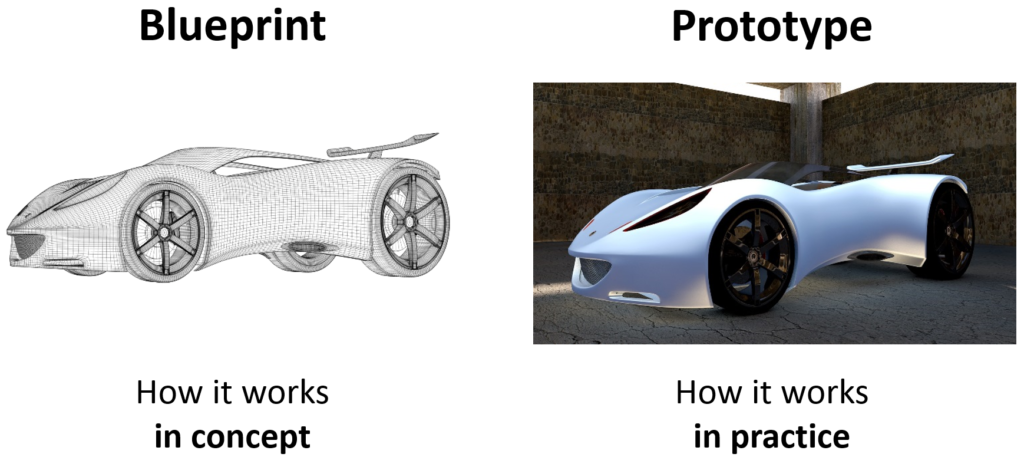
June 7, 2019
The Business (Activity-Based) Prototype
5 minute read
The prototype is a critical step in going from a blueprint to a detailed, final build plan. It bridges the gap between how elements will fit together “in concept” to how elements will fit together “in practice.” For example, when inventing a new product the prototyping step is critical to understand how the product works, which enables learning and adapting early in the process when it’s faster and cheaper. Similarly, in architecture, a prototype (whether physical or electronic) of a new building drives clarity on how the new building would work, in practice.
When figuring out the best way to build a new business – which is more complex than building a product or building – prototyping is likewise a critical step in figuring out how each “blueprint” (i.e. how the pieces of a business fit together, in concept) would work from an operational and financial perspective.
Translating Performance on Activities to Results
To build a business prototype (i.e. prototype of how a new business would work), we start with a base P&L model which gives us a structure for most key business measures such as revenues, COGS, gross profits, expenses, and net profits. From this starting point, the business prototype has the following two important differences:
- It’s an activity-based model – that is the model inputs are the in-market “activities” to be performed to operate the business (e.g. driving consumer awareness, getting distribution in retail channels, manufacturing products and delivering them to stores, etc.). An activity-based prototype enables us to understand how performance against activities translates into outcomes. This is critical to understanding the financial results at varying levels of performance (e.g. what will revenues be if we perform at the high end of the range of expectation vs. the low end).
- It’s used as a design tool not a performance hurdle. In other words, it’s a tool where you can understand how changes to the blueprint building blocks and the corresponding range of expected performance across activities translates into outcomes, which guides the choices you make in figuring out the best blueprint.
Clarity at the Activity-Level is Critical
Here’s an example. A company approached us to understand why a launch was performing ~50% below the volume forecast. Both the concept and the product had scored well in testing and the volume forecast was above the stage gate hurdle. In addition, they had found a new package that was preferred by consumers to the one shown in the concept testing. Though the new packaging used a smaller pack size than tested (4-pack of 12 oz bottles instead of a 6-pack of 16 oz bottles), the retail price point and price per ounce were lower than tested and retailers loved the new package, so they decided to make a switch and the product was launched with the smaller pack.
The “miss” was driven by the fact that the traditional financial model doesn’t get to the activity level, limiting its ability to adjust to new information without expensive testing. Since the traditional model used the research volume forecast that gave little visibility into the activities that made up the forecast, it was easy to rationalize that consumers would consume the same since the retail price/pack was lower and the price/ounce decreased. If an activity based model had been used, however, the team could have seen that for volume to remain the same after making this pack change, the “packs/purchase” or “purchase frequency” would need to increase to levels that would have been in the top 5% of packs in the category. Not impossible, but certainly changes the risk profile and the focus of the team upon making this change.
Key Points:
- Much like you would build a product prototype to understand how a new product would work, a business prototype enables us to understand how a new business would work.
- While a business prototype is built around the traditional financial tools of a P&L and Cash Flow statement, it’s different in that the business prototype is a design tool to understand how blueprint choices impact financial potential – not an evaluation tool to meet a hurdle.
- A business prototype is most effective when it’s an “activity-based model,” that is, the model inputs are the “activities” to be performed to build and operate the business (e.g. developing the product, driving consumer awareness, getting distribution in retail channels, manufacturing products and delivering them to stores, etc.), which enables understanding on how performance against each activity translates into results.
- A business prototype enables us to quantify the range of financial potential for a business blueprint based on the range of performance across the different activities required to build and operate the business. The business blueprint defines how a business would work in concept and the “business prototype” enables us to understand how a business would work in practice (i.e. operationally and financially)


